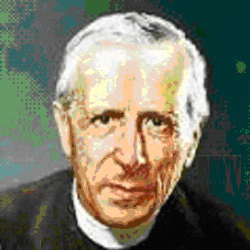In the Fall of 1987, I came to Palo Alto to begin my studies in Transpersonal Psychology. There was a Woolworth’s store on University Avenue then, and I stood outside looking at some items behind the large, glass storefront, trying to see if they had two-inch binders for sale. Because of the angle of the sun, however, all I could see was the sheen of sunlight on the window, and my own reflection in it. Eventually, I managed to adjust my focal length, adopt a ‘soft gaze’ and penetrate the glare. And bingo! there were the two-inch binders. It quickly became a metaphor for me in how we need to change perspectives in order to see into other realities; to shift our vision from the normal state of consciousness to altered states of consciousness and, hence, access new dimensions.
And that is how dreams, visions and mystical meetings occur. When speaking of the kingdom of God to parishioners in Kenya, I would pun in Kiswahili and say, “Mbinguni si mahali, bali ni hali” (heaven is not a place, rather it is a state of consciousness.) Unfortunately, the pun doesn’t survive translation!
So, in this blog, I want to speak of dreams and visions, and how to harvest our sorties into altered states of consciousness.
A. Some Definitions
A vision is simply a dream you have while you are awake, and a dream is simply a vision you have while you are asleep. In Biblical Hebrew, ‘dream’ and ‘vision’ are synonyms. So, when, in his Pentecost homily, Peter quotes the prophet Joel, he is not guilty of ageism when he says, regarding the time of the Messiah, “your young men will see visions and your old men will dream dreams.” It is obvious from the rest of Joel’s prophecy that the Spirit will not play favorites:
“In the last days, God says,
I will pour out my Spirit on all people.
Your sons and daughters will prophesy,
your young men will see visions,
your old men will dream dreams.
Even on my servants, both men and women,
I will pour out my Spirit in those days,
and they will prophesy.”
B. Thin Places – Caol Áiteanna
In Celtic thinking, liminal spaces (thresholds) are called, ‘thin places” (in Gaelic, ‘caol áiteanna’). They are the antechambers to other dimensions, conferring altered states of consciousness on the courageous pilgrim; and the promise of meeting with extra-dimensional entities and energies. It is highly recommended that the unprepared not blunder into those realms because one of two tragedies will occur – inflation (where the ego thinks it’s God) or madness (where the ego completely loses its moorings and crashes into the ‘normal-reality’ state, upon re-entry.) Hence, ancient societies made it taboo for the uninitiated to attempt access e.g. “it is a terrible thing to fall into the hands of the living God.” (Hebrews 10:31) In fact, I believe that the first notion of sin was the breach of this taboo. From that new understanding, then, a ‘selfie’ is a photo taken by the ego in a normal state of consciousness, while a vision/dream is a photo taken by the soul in an altered state of consciousness.
For the Celts, such liminality was not confined to physical locations – though wells, lakes, rivers, rocks, mountains and groves of trees were often ‘thin places.’ Thus, certain people e.g., mystics, prophets, bards, ovates, druids and artists could be mobile thin places – tabernacles of the sacred. And certain times e.g. dawn, dusk, Imbolc (February 1st.), Bealtaine (May 1st.), Lughnasa (August 1st.) and Samhain (November 1st.) also had the power to temporarily render diaphanous the veil between the mystical and the mundane, between the sacred and the secular.
Birth and puberty and death were also occasions of liminality and, thus, had to be negotiated with appropriate community-wide rituals.
But even we ‘moderns’ experience ‘thin places’ at least twice daily – as we enter sleep and exit sleep. Psychology calls these states, ‘hypnagogic’ (as we enter sleep) and hypnopompic’ (as we exit sleep.) When properly navigated, these two transitions can yield rich, mystical harvests.
One of the great advantages of being ‘semi-retired’ is that I seldom have to wake to an alarm clock. So, I’ve learned to milk these transitions. I can then turn the last dream of the night into a lucid dream where the physical laws of time, space and causation are set aside and intuition, déjà vu, insight and out-of-the-box thinking become the coin of the realm. Most of my best, creative ideas come to me in these ‘caol áiteanna.’ I keep a pen and paper at my bedside and hastily scribble a few key phrases to be revisited later in order to reconstruct the entire edifice of the dream/vision.
C. Eucharist and Resurrection
In lieu of the above, I now want to say a few quick words about Eucharist and Resurrection, both of which can only be understood and experienced in an altered state of consciousness. It should now be obvious that Holy Communion does not involve chewing on the physical flesh of Jesus; that he did not clone himself 100 trillion times so that 1.2 billion Catholics could receive his body and blood, soul and divinity weekly – or even daily – for the last 2,000 years; rather, it means your soul-self dancing with his soul-self.
And his resurrection did not involve re-assembling the molecules of his matter, which after three days in the burial cave, were being ecologically recycled back into the environment. Rather, he activated his own soul-self, his ‘pneuma spiritualis’, and then those of Magdalene, the two disciples on the road to Emmaus and, finally, the eleven disciples in the Upper Room, all of whom were now ready to make the mystical, quantum shift. For there is no such thing as an after-life, only an also-life, available even now through a shift in consciousness. Eucharist and Resurrection are about reaching Christ consciousness or the recognition of our Buddha nature, which incarnation had temporarily occluded.
What about you, then, in this Easter season? Are you ready to really receive Holy Communion? To meet the resurrected Jesus? Can you make the mystical leap that transcends your senses, and trust what your soul is telling you? If you can, then Eucharist is Real Presence and Resurrection is Now.













